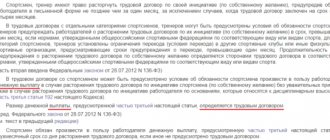Law on dismissal of alimony worker
The procedure for the employer's actions in the event of dismissal of the alimony worker is regulated by Art. 111 IC RF and Art. 5 No. 229-FZ. According to this article, a company that withholds alimony on the basis of a court decision or a certificate certified by a notary is obliged to report the dismissal of an employee to the executive authorities. The deadline for this is three working days. Also, the person receiving alimony - the second parent - is notified of the dismissal of the alimony provider. If the employer has information about the subsequent place of work of the alimony payer, he must provide this information too.
When moving from one place of work to another, the parent involved in paying child support does not have the right to hide the new place of employment. He must inform the bailiff and the person receiving alimony about the change of employer. Notification of additional earnings, if any, is also required. Failure to comply with these requirements may result in the responsible persons being subject to administrative liability.
The child support worker has become your employee
S. Bakina, General Director of ProAudit LLC
The company received a writ of execution. Be careful: not all of the employee’s income will be included in the alimony calculation base.
Most often, parents who are divorced are faced with paying child support. If one of them refuses to support their minor child, then the second parent has the right to demand payment of money through the court.
Parents can decide the issue of paying child support without the participation of judges. In this case, they enter into a written agreement. Certified by a notary, it has the force of a writ of execution.
As a rule, child support is paid until the child reaches 18 years of age. By court decision, this obligation may be terminated earlier. In some cases, the terms of alimony payments are extended.
Basis for accrual
Alimony is paid monthly. The basis for their retention is a writ of execution or an agreement. Each document contains mandatory details. Thus, the agreement must be signed by the parents and certified by a notary (Article 100 of the RF IC). But there are more requirements for the writ of execution. According to Article 8 of the Federal Law of July 21, 1997 No. 119-FZ, the document must contain:
- name of the court that issued this document;
- number of the case for which the writ of execution was issued;
- surnames, first names and patronymics of the claimant and debtor, their residential addresses, as well as the date and place of birth of the debtor, and his place of work;
- an extract from the court decision, which contains the resolution on this case;
- date of entry into force of the court decision;
- the date of issue of the writ of execution and the deadline for presenting it for execution;
- judge's signature and official seal.
If an employee from whom alimony is being withheld quits, then the administration of the enterprise must notify the recipient of the money and the bailiff about this (Article 111 of the RF IC).
Calculation procedure
The list of payments from which alimony can be withheld is given in Decree of the Government of the Russian Federation of July 18, 1996 No. 841, and the list of payments that are not included in the calculation base is in Article 69 of the Law of July 21, 1997 No. 119-FZ.
Thus, payments from which alimony cannot be withheld include severance pay upon dismissal. Also, from the calculation base it is necessary to exclude financial assistance that is issued in connection with the birth of a child, registration of marriage or death of close relatives.
Citizens pay alimony not only from earnings from their main place of work, but also from income from part-time work.
As a rule, alimony is withheld in the following amount:
- for the maintenance of one child – 1/4 of the employee’s income;
- for the maintenance of two children – 1/3 of the employee’s income;
- for the maintenance of three or more children – 1/2 of the employee’s income.
The size of these shares can be changed (reduced or increased) by the court, taking into account the financial or marital status of the parties and other circumstances (Article 81 of the RF IC).
Paragraph 4 of Decree of the Government of the Russian Federation dated July 18, 1996 No. 841 states that alimony is collected from income after personal income tax has been withheld from it. At the same time, the accountant should remember that the alimony payer has the right to a standard deduction for the child. The amount of the deduction is 600 rubles, it is provided until the month in which the employee’s income exceeds 40,000 rubles (subclause 4. clause 1 of article 218 of the Tax Code of the Russian Federation). Citizens receive a deduction for each child under the age of 18, as well as for children under the age of 24 if they are full-time students.
If a single parent (not married) pays child support, then standard deductions for children are provided to him in double amount. It turns out that divorced parents can both receive a double reduction. When they enter into a new marriage, from the next month after registration they are provided with a single deduction for the child.
To receive a double deduction, the employee must write an application, submit a copy of the passport, which does not have a registry office mark on marriage registration or contains a mark on divorce. A writ of execution for payment of alimony or an agreement is also required.
Accounting records
Alimony is withheld when calculating wages and transferred to the recipient within three days from the date of payment of wages. An example will show what entries an accountant will make in relation to an employee paying alimony.
Example
In June 2005, employee of Passiv LLC Nikolai Anisimov was accrued: salary - 12,000 rubles, quarterly bonus - 9,000 rubles, as well as financial assistance in connection with registering a marriage - 7,000 rubles. In April, Nikolai Anisimov was already paid financial assistance in the amount of 3,000 rubles.Based on the agreement on the payment of alimony, the Passiva accountant withholds alimony from Anisimov for the maintenance of his son in the amount of 1/4 of his earnings. When calculating alimony, it is necessary to take into account salary and quarterly bonus. Financial assistance will not be included in the calculation of alimony.
Considering that Anisimov’s income exceeded 40,000 rubles, he is not provided with standard deductions.
Let's calculate the total amount of personal income tax:
(RUB 12,000 + RUB 9,000 + RUB 7,000) x 13% = RUB 3,640
Since not all income is included in the base for calculating alimony, not the entire amount of personal income tax will reduce the calculation base. Personal income tax, which relates to the calculation base for alimony, is equal to:
(RUB 12,000 + RUB 9,000) x 13% = RUB 2,730
The amount of alimony will be:
(12,000 rub. + 9,000 rub. – 2,730 rub.) x 1/4 = 4,567.50 rub.
Alimony is transferred to the ex-wife by postal order. Postal services for transferring money are paid for by Anisimov (Article 109 of the RF IC). The cost of services is 3 percent of the transfer amount. Thus, when calculating deductions, postage costs must also be taken into account. Their value is equal to:
4567.50 rub. x 3% = 137.03 rub.
The amount that Anisimov will receive in his hands will be:
(12,000 rub. + 9,000 rub. + 7,000 rub.) – 3,640 rub. –
– 4567.50 rub. – 137.03 rub. = 19,655.47 rub.
In accounting, the Passiv accountant made the following entries:
Debit 20 Credit 70
– 21,000 rub. (12,000 + 9000) – wages and quarterly bonus accrued;
Debit 91-2 Credit 70
– 7000 rub. – financial assistance has been accrued in connection with marriage registration;
Debit 70 Credit 68 subaccount “Calculations for personal income tax”
– 3640 rub. – personal income tax was withheld from Anisimov’s salary;
Debit 70 Credit 76 subaccount “Settlements based on writs of execution”
– 4704.53 rub. (4567.50 + 137.03) – the amount of alimony and the costs of their postal transfer were withheld from Anisimov’s salary;
Debit 70 Credit 50
– 19,655.47 rub. – Anisimov’s salary, bonus and financial assistance were issued from the cash register minus deductions;
Debit 76 subaccount “Settlements on writs of execution” Credit 50
– 4567.50 rub. – the amount of alimony has been handed over to the cash desk of the postal organization;
Debit 76 subaccount “Settlements on writs of execution” Credit 50
– 137.03 rub. – expenses for postal transfer of alimony have been paid.
attention
The maximum amount of alimony cannot exceed 70 percent of income (Article 66 of Law No. 119-FZ of July 21, 1997).
In what cases can a child support worker be fired?
The fact that an employee is a child support worker does not protect him from dismissal . The employer has the right to dismiss such an employee, like any other, for the following reasons:
- evasion of fulfillment of assigned obligations;
- absenteeism;
- inadequacy for the position held;
- staff reduction.
Additional information
All this is described in detail by Article 81 of the Labor Code. If there are compelling reasons, the employer has the right to dismiss the alimony payer as well as an employee not burdened with monthly payments.
Dismissal procedure
Regardless of what was the reason for terminating the employment relationship between the employee and the employer - failure to fulfill labor obligations or the personal desire of the person to leave his position - the procedure for dismissing the alimony payer must be followed. For example, when removing a person from a position for absenteeism, the procedure will be as follows:
- identification of the fact of absenteeism and documentary evidence (memo, act, etc.);
- determining the reason for absenteeism - the presence or absence of valid reasons;
- registration of dismissal under the relevant article with making a note in the work book and personal file.
Because the presence of minor children who are entitled to monthly payments is not a “mitigating circumstance,” an employee can be dismissed according to the same scheme and on the same grounds as other employees. The only nuance can be considered an increase in bureaucratic procedures and mandatory compliance with the following formalities:
- drawing up and sending notices and writs of execution to bailiffs;
- sending a corresponding notice to the second parent receiving child support.
The employer is responsible for the timely provision of the specified documentation to the authorities.
Dismissal by agreement of the parties
Termination of an employment contract by agreement of the parties implies the accrual of certain payments to the employee. In this case, it does not matter which party initiated the termination of the employment relationship; the main thing is that this fact is recorded in the document.
An employee dismissed by agreement of the parties is entitled to the following payments:
- wages for all time worked from the date of accrual of the last salary;
- compensation for unused vacation periods.
Dismissal by agreement of the parties is voluntary and does not provide for any additional payments. The funds received relate to the employee's remuneration for the work performed. Thus, the above types of payments are considered income and are subject to alimony payments. The accounting employee is obliged to calculate alimony from this money after he has withheld income tax and taken into account the tax deduction.
Alimony from vacation compensation
According to the Labor Code, vacation compensation can:
- made in cash, by accruing vacation pay for the required days of rest;
- goes towards the vacation of the employee’s new position if he remains employed in the previous organization.
If compensation for vacation is paid in money, then alimony is calculated from it in the general manner. When transferring vacation periods to a new place of work, no deductions for alimony are made.
Alimony from severance pay
Article 178 of the Labor Code of the Russian Federation regulates the procedure for calculating and paying severance pay. It is intended to provide financial support to employees dismissed for the following reasons:
- staff reduction;
- company reorganization;
- liquidation of the enterprise.
This payment is calculated based on average earnings and is equal to three times the average monthly income.
The Family Code states that alimony is withheld from severance pay only if it is paid for a minor child.
Alimony is not calculated from severance pay if the recipient of the funds is:
- disabled spouse;
- parents;
- a disabled child who has reached the age of majority;
- a spouse caring for a minor disabled person of group 1 or 2, who was previously listed as disabled as a child.
How to create a notification?
As a rule, the HR department is responsible for preparing a letter to the bailiff service. The notice of dismissal of the alimony provider is drawn up strictly in accordance with the sample. Only in this form will it be accepted for consideration. The document is drawn up in the application format. It must contain:
- table of contents or “header” of the document;
- date of dismissal of the employee and termination of employment;
- the position held by the employee before termination of the contract;
- amount of payments.
The notice of dismissal of the alimony provider is marked with: date, signature and seal.
It is also necessary to take care of timely notification of the employee’s wife (husband). The other parent and child have a legal right to know the work status of the person paying child support. Such a notification indicates on what date and on what grounds the alimony payer was dismissed, and therefore transferred from the status of “payer” to the status of “debtor”.
At the top you should indicate the name of the organization itself, followed by information about the recipient - in whose name the notification is written. For example, “To the bailiff in the OSP for the Zelenograd joint-stock company.” Then the next line indicates the last name, first name and patronymic of the person receiving alimony. For example, “To the collector of alimony, Surina Irina Nikolaevna.” Below is the phrase “Message about the dismissal of an employee.” The subsequent text in the notice reflects information about the reason for the dismissal of the alimony worker, for example, under the article or at his own request. If the employment contract is terminated due to absenteeism or neglect of assumed obligations, then the letter indicates the article under which the employee was dismissed.
How to send a notice to the bailiff service?
In Art. 111 IC RF and Art. 5 No. 229-FZ states that the employer is obliged to send a notice to the bailiffs within three days from the date of dismissal of the alimony worker. However, there is no exact time frame for returning the writ of execution. The best solution would be to send the documentation the next day after dismissal. There is no point in delaying this, since untimely notification of executive authorities about the removal of an employee from position is punishable in accordance with Part 3 of Art. 17.14 Code of Administrative Offenses of the Russian Federation:
- a fine of 15-20 thousand rubles for an official who neglects his obligations;
- a fine of 50-100 thousand rubles, which is imposed on an organization for late notification.
You can provide all documents to the bailiffs by mail - registered mail with notification. In exactly the same way, a letter is sent to the second parent – the child support collector.
What should an accountant do?
After the dismissal of the alimony worker, the accountant needs to do important work - collect a personal file and send it to the company’s archives. The following documents should be placed in your personal file:
- a copy of the writ of execution, which contains information about funds withheld from wages and the balance of payments;
- a duplicate of the dismissal order;
- copies of notification letters sent to the executive authorities and to the second parent;
- a list of papers that make up a personal file.
If the company has a documentation log, then a corresponding note is made in it, the date of dismissal and sending of documents is indicated.
Accounting documents for a dismissed alimony worker
The accountant must leave in the personal file of the dismissed person:
- a copy of the agreement, writ of execution or order in order to confirm
the grounds on which alimony was calculated; - a copy of the order on the basis of which the alimony worker was dismissed;
- a copy of the letter sent to the bailiffs or alimony recipient;
- a list of documents enclosed in the letter;
- notifications of receipt of letters;
- If the organization keeps a journal in which the enforcement documents of alimony workers are taken into account, then a note is made there indicating the date of dispatch.
Documents must be kept in the organization in case bailiffs verify the correctness of the process of withholding and transferring payments.
Retroactive dismissal of an employee
It often happens that the alimony payer introduces ambiguity into the issue of employment, dismissal or continuation of work in the same place. For example, he repeatedly plans to submit his resignation and then changes his mind. A company manager may be faced with a difficult question regarding what to do if an employee is fired retroactively. After all, in fact, we are dealing with a violation of the law in the form of delays.
For untimely submission of a writ of execution and some other inconsistencies, the employer may be punished with a fine. Therefore, it is extremely important to correctly explain the reason for the untimely submission of documents to the executive bodies. If an employee regularly committed unlawful acts, failed to fulfill assigned obligations, or was noted for absenteeism, the employer can fire him on his own initiative by applying the article. In this case, the retroactive dismissal of the alimony payer cannot be considered a violation of the law.
Nuances
The dismissal of an alimony payer does not mean the termination of payments. After delivering a letter of termination of the employment contract to the second parent, he has the right to control the situation by inquiring about the receipt of information about the new place of work from the bailiffs.
A notification letter must be sent to the parent on the day of termination. Timely information is clearly regulated by law. A delay of even one day may be grounds for filing a complaint.
The employer's procedure after dismissal of the alimony payer
After the employer terminates the employment contract with the alimony payer and makes a full payment with the deduction of alimony payments based on the requirements of the law, he is obliged to do the following:
- Report the fact of dismissal of the employee to the bailiff service and the alimony recipient. If the document on the collection of alimony was sent by the court, the organization notifies the judicial authority.
- The notice is provided in writing, indicating the date of dismissal and the new place of employment, if known to the employer.
- Submit a writ of execution to the bailiff service, completed in accordance with the requirements of the law.
The following data is entered into the executive document:
- the total amount of funds withheld from the payer;
- the period of time for which the deductions were made;
- the amount of debt incurred and the reasons why it was formed.
Important! Failure to comply with these requirements will result in administrative liability for the employer and the imposition of a fine.
Employer's liability
The dismissal of the alimony payer does not at all mean the end of obligations for the corresponding payments. After sending a notice of termination of the employment agreement to the other parent, he can control the subsequent process by inquiring from the bailiffs about the receipt of data regarding the new place of work.
Notice must be sent to the parent on the day of termination of the agreement. Timely notice is clearly stated in labor laws. Being late, even one day, is considered grounds for initiating an administrative case.
The employer can be held liable for failure to comply with the mandatory rules for dismissing the alimony payer. This includes:
- fine 30-120 thousand rubles. for an enterprise and 10-25 thousand rubles. for management for lately sending a document with information about funds withheld from wages.
- fine 3-5 thousand rubles. from the enterprise, 400−600 rub. from management - for untimely notification of executive bodies about the termination of the agreement.
Bailiffs have the right to monitor and analyze the work of the HR department, as well as monitor the fulfillment of obligations to pay alimony.
Being aware of the rules for terminating the employment agreement of alimony payers and the deadlines for fulfilling obligations regarding the provision of documents to executive bodies, you don’t have to worry about problems with the law.









